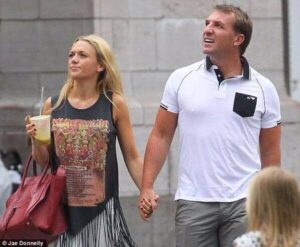C’MON the Stripes certainly doesn’t have the same ring to it, not to mention uniqueness, as C’mon the Hoops, but if we still wore stripes there’d be no point in adopting the chant – we’d just be another team in stripes!
But Celtic aren’t just any other team and that isn’t just down to a history of breathtaking performances on the field or the fact that over 80,000 supporters travelled all the way to Seville and grabbed headlines throughout the world.
There is a bond between the players and supporters, and one of the strongest links in that bond is the shirt they both wear on their backs.
And it is the distinctive and eye-catching green and white Hoops that have made people on all corners of the globe with no obvious connection to Celtic sit up and take notice.
There are those who follow the fortunes of Celtic from afar, and when asked what first attracted them to the club nine times out of 10 the answer isn’t Nine-in-a-Row, Lisbon, Jimmy Johnstone, Kenny Dalglish, Henrik Larsson or Kyogo…
Quite simply, the first words out of their mouths are usually: ‘The strip.’
The Hoops are a badge of honour we wear with pride and the great Jock Stein knew exactly what he was talking about when he said: “The Celtic shirt doesn’t shrink to fit mere mortals.”
Whoever had the idea 120 years ago to change the strip in those pre-marketing replica kit years couldn’t possibly have known what a historic decision he was making – the green and white Hoops are a promotional tool that money just can’t buy and are instantly recognisable throughout the world.
It hasn’t been recorded who actually made the decision, but J H McLaughlin was chairman at the time while Willie Maley ran the football side of things so both were probably involved in some capacity.
It was probably the most significant transfer we ever made and remarkably the Hoops are almost certainly an import from Govan of all places.
Junior club, St Anthony’s have supplied many a player to Celtic down through the decades but history also notes that they were the original Glaswegian wearers of the green and white hoops – although Hibernian wore the Hoops between 1876 and ’79 with HFC on the chest.
It was noted at the time that somebody at Celtic Park simply took a fancy to the strip after watching St Anthony’s play and the legend of the Hoops was born.
The irony is that St Anthony’s and their followers in Govan are well-known for their Celtic allegiances and a symptom of that is that many believe they wear the Hoops because they are Bhoys’ fans, when the reality is that they blazed a trail and Celtic simply followed suit.
It wasn’t all plain-sailing for the natty new threads, though, as in the early days there were references in the press likening the Celtic players to convicts.
Just compare the early version of the Hoops to the prison garb worn by George Clooney and co in Oh Brother Where Art Though and you will know where they were coming from, but C’mon the Convicts is about as appealing as C’mon the Stripes.
Still, it’s understandable why the Convicts moniker never caught on as one Canadian journalist who wrote of the Celts on tour as, ‘turning out in jailhouse jerseys’ had to change his phone number when ex-pats literally got shirty and turned on him with some venom.
It should be noted, though, that Celtic spent nigh on the first 15 years of their existence playing in the club’s early colours, so many ‘Hoops’ legends such as Sandy McMahon, James Kelly, Jimmy Blessington and Willie Maley himself never actually wore the Hoops.
The very first strip was, of course, white shirts with a green collar and a Celtic cross in red and green on the breast.
As Maley stated in his 1939 book, The Story of the Celtic: ‘These were presented to the club by Penman Bros., then the big drapers and clothiers at Bridgeton Cross.’
The strip soon changed to the green and white vertical stripes and that was the preferred option until 1903 and the sartorial elegance of the Hoops, when ‘somebody at Parkhead’ was watching rather more than the tactics of St Anthony’s.
So did the magic of the Hoops rub off on the team right away?
When the Celts had changed to the stripes they reached the Scottish Cup final but lost 2-1 to Third Lanark.
However, when changing to the Hoops they also reached the final in their first season of use with an altogether more acceptable outcome.
Celtic met arch rivals Rangers in the Scottish Cup final of 1904 and, despite being two goals down after 12 minutes, the great Jimmy Quinn made sure of his own chapter in the history books by scoring Celtic’s first ever Scottish Cup final hat-trick… and the Hoops never looked back.








